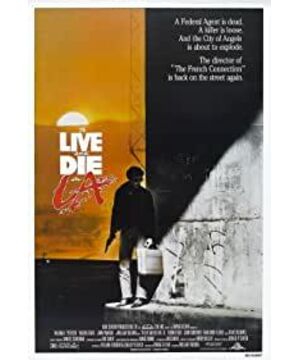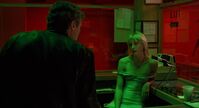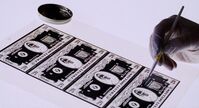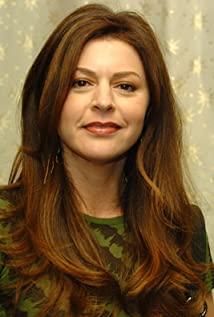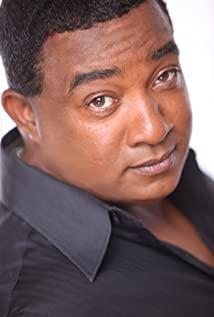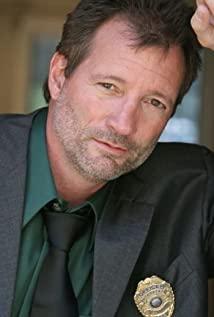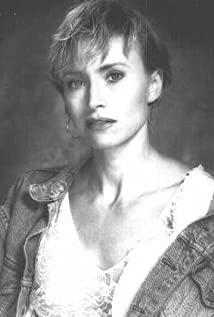William. "French Drug Network" directed by Fred King in 1971 can be regarded as a model that created a new police film in the 1970s, and made major breakthroughs in story and special effects. In 1974, he shot the horror film "The Exorcist", which shocked the world, and these two films alone can rank him as a master of the 70s. But since then, he has hardly made a decent film again, and that "Threatening" is just a remake of Cruzo's masterpiece. Many directors like to repeat the same old way when their careers are down. Fred King was no exception in the mid-1980s. He almost copied the successful experience of "French Drug Network" and filmed this "Wavy Warrior" (Life and Death). Los Angeles). It just replaced the drugs in the "French Drug Trafficking Network" with counterfeit banknotes and replacing France with Los Angeles in the United States. On the surface, this is an old-fashioned popular police movie, but it's not. The script is very complicated. In addition to the depiction of the crime, the action of the big scene, the gunfight and the speed chase, there is also a vivid presentation of the pros and cons. From the perspective of character design and narrative, the two roles of Richard and Eric are mirror images of each other, that is, the pros and cons are morally ambiguous. In fact, there are many such settings, such as Hitchcock's "Fresh and Furious", Wu Yusen's "Face-Stopping Heroes" and so on. They don't have a clear definition of good and evil, because they have flaws in their personalities, they are very fragile, and they all make mistakes. Richard is an adventurist who loves to chase death and has anti-hero qualities. He is not justice-he blackmails female informants who provide him with tips from time to time, enjoys her physically, and controls her mentally (in order not to arrest She used it as a means of coercion); even more irresponsibly pulled her companions into the water (manslaughter the FBI) and so on. In these episodes, it is not difficult to find that the nature of the police and criminals are so similar. They understand each other’s words and actions, and the boundary between good and evil is blurred. This is already very clear in Infernal Affairs. Compared to Richard, the "funger" Eric seems to be more kind. He is "bad" on the surface, but there is a kind of "feminine" in his bones. He appreciates oil paintings and avant-garde singing and dancing-his obsession and devotion to the printing of counterfeit banknotes at the beginning, just like his creation of oil paintings, both belong to his works of art, and he likes to burn his own works (the title burns oil paintings, The counterfeit banknotes were burned later), and at the end, he accidentally burned himself when confronted with John. He was born by fire and died by fire, so to speak- He himself is also his work of art. The other side line is the "partner relationship", with Jean. Hackman, Roy. Like Schade, the two partners (Richard and John) in "The Wight Ark" are also a relationship of complementarity and growth, but this relationship is sublimated at the end. The latter gradually replaced the former after the former was shot and killed. He has been assimilated by Richard’s dark side. Although this role was a little cowardly, but somewhat of a sense of justice, at the end he not only became a “reason” in speech and dress. "Cha", and more importantly, he inherited Richard's "hypocrisy"-he continued to maintain a "cooperative" relationship with the female informant. And the two female characters in the film (Richard’s Girlfriend & Eric's girlfriend), the two are also a mirror relationship. The former was also Richard’s informant. Because he needed money and he had a handle, he reached a “partner relationship” of “money” and “physical” cooperation. Later, he wanted to leave this place after learning of Richard’s death. This city, who knows, has continued this relationship with John; and Eric’s girlfriend also has a cooperative relationship in it. There was a scene where she went to Eric’s colleagues to ask for money, and she deliberately attracted colleagues to the bait. With his hands and feet, he left the door for Eric to come in and provoke him. It can be seen that this method is not the first attempt. The two are also a "partner relationship" between "money" and "physical". And in the end, Eric found a female partner for her, and we discovered that the two of them were just acting on the spot. This girl is either lace or bisexual. This new female partner is true love – in the end she and that The female companion flew far away. The relationship between the characters is so far, and all the protagonists use each other, not only the protagonist, but also the other supporting characters in the film. From the corruption of the legal system to the personal gains of individuals, all the characters in the film are morally dirty and hypocritical...false currency, false motives, false loyalty, and false interpersonal networks. The "net" of the "U.S. Counterfeit Banknote Network" is much denser and more complex than the "net" of the "French Drug Trafficking Network." [City] Compared with the characters, the city of Los Angeles is real. It is more like the protagonist of the story. I have said before that the backgrounds of many genres in Western films are not only typographical backgrounds, but effective Participated in the narrative, in fact, many types of films in the United States are no exception, such as San Francisco in "Victorius", this film is also the best proof- The main road, the overpass, and the oil refinery all match the tone of the film and have their specific symbols and meanings. Through the theme of the story, these urbanization symbols are made more real, especially the speed chase scene in the film, which completely integrates the emotions of the characters and the noise of the city. The director puts the speed chase in the opposite direction of the highway instead of the general same. Chasing in the direction, the protagonist is also responsible for embezzling the black money of the diamond trade, on the back of the charge of indirect murder of the FBI agent, which runs counter to the morality of justice, and then he began to drive in the opposite direction; technically, the director William. Fred King is also looking for a breakthrough. He can see the courage that he vowed to break through the "French Drug Network" car scene, precise route and powerful stunts (over the train, hide the car on the slope and drive in the opposite direction). The control of time is quite dynamic, and the wide-angle lens also allows the audience to see the long lines of vehicles in the distance, which is very realistic. The refined operation of the mirror and visual style, especially the use of the follow-up lens, is not only extremely real, but also vividly expresses the industrialization and diversification of the city of Los Angeles. Although it cannot be said that it surpasses the "French Drug Network" technically, it is definitely a high-level performance, no less than the speed scene in "Police Net King Kong" or "Breathtaking Island". To make a digression, talking about the take-off car chase scene, I think the best director so far is still John. Frankenheimer. Not only the speed scene, but many locations in the film made Los Angeles very charming. The film’s photography was Robby Müller of "Texas, Paris". It is not difficult to find from the film that it is the same as "Texas, Paris". The rough gravel and urban tone, as well as the excellent percussion soundtrack, also give the city a sense of movement. [Ending] When watching the DVD highlights, they found that the film also included another ending instead of the ending where the protagonist is now dead. They only played the ending once. It was filmed by the film company, just like William. According to Fred King, that kind of thing is really a bad ending, and as the male protagonist said, it is an ending that can only be seen in a police movie like "The Ultimate Detective of Beverly Hills". I like the ending now, because only in this way can the characters be fuller and more real, and can we reach the beginning and end where justice and evil are mirror images of each other. Müller), it is not difficult for us to find the same rough gravel and urban tone as "Texas, Paris" from the film, and the excellent percussion soundtrack also gives the city a sense of movement. [Ending] When watching the DVD highlights, they found that the film also included another ending instead of the ending where the protagonist is now dead. They only played the ending once. It was filmed by the film company, just like William. According to Fred King, that kind of thing is really a bad ending, and as the male protagonist said, it is an ending that can only be seen in a police movie like "The Ultimate Detective of Beverly Hills". I like the ending now, because only in this way can the characters be fuller and more real, and can we reach the beginning and end where justice and evil are mirror images of each other. Müller), it is not difficult for us to find the same rough gravel and urban tone as "Texas, Paris" from the film, and the excellent percussion soundtrack also gives the city a sense of movement. [Ending] When watching the DVD highlights, they found that the film also included another ending instead of the ending where the protagonist is now dead. They only played the ending once. It was filmed by the film company, just like William. According to Fred King, that kind of thing is really a bad ending, and as the male protagonist said, it is an ending that can only be seen in a police movie like "The Ultimate Detective of Beverly Hills". I like the ending now, because only in this way can the characters be fuller and more real, and can we reach the beginning and end where justice and evil are mirror images of each other. Müller), it is not difficult for us to find the same rough gravel and urban tone as "Texas, Paris" from the film, and the excellent percussion soundtrack also gives the city a sense of movement. [Ending] When watching the DVD highlights, they found that the film also included another ending instead of the ending where the protagonist is now dead. They only played the ending once. It was filmed by the film company, just like William. According to Fred King, that kind of thing is really a bad ending, and as the male protagonist said, it is an ending that can only be seen in a police movie like "The Ultimate Detective of Beverly Hills". I like the ending now, because only in this way can the characters be fuller and more real, and can we reach the beginning and end where justice and evil are mirror images of each other. Müller), it is not difficult for us to find the same rough gravel and urban tone as "Texas, Paris" from the film, and the excellent percussion soundtrack also gives the city a sense of movement. [Ending] When watching the DVD highlights, they found that the film also included another ending instead of the ending where the protagonist is now dead. They only played the ending once. It was filmed by the film company, just like William. According to Fred King, that kind of thing is really a bad ending, and as the male protagonist said, it is an ending that can only be seen in a police movie like "The Ultimate Detective of Beverly Hills". I like the ending now, because only in this way can the characters be fuller and more real, and can we reach the beginning and end where justice and evil are mirror images of each other.
View more about To Live and Die in L.A. reviews


